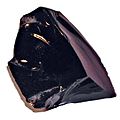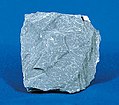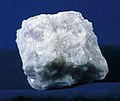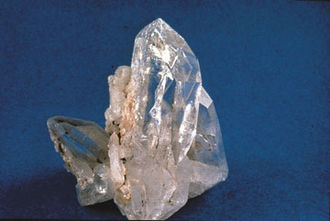AY Honors/Rocks & Minerals/Answer Key
1. What is the difference between rocks and minerals?
A mineral is a naturally occurring, inorganic solid with a definite chemical composition and a crystalline structure formed by geological processes. A rock is an aggregate of one or more minerals. (A rock may also include organic remains and mineraloids.) Some rocks are predominantly composed of just one mineral. For example, limestone is a sedimentary rock composed almost entirely of the mineral calcite. Other rocks contain many minerals, and the specific minerals in a rock can vary widely. Some minerals, like quartz, mica or feldspar are common, while others have been found in only one or two locations worldwide.
2. Have a collection of at least 15 specimens correctly labeled with collector’s name, date, and the locality in which it was found.
Identifying rocks and minerals is best done with a Field Guide. The following properties are very useful for identification purposes:
- Hardness
- Cleavage
- Specific gravity
- Luster
- Color
- Streak
- Texture
- Crystalline structure
These are described in detail in requirements 4 and 5.
You will need a few tools for measuring various aspects of rocks. Not all of them are required, but the more of them that are available to you, the more successful you will be in identifying specimens.
- Specific Gravity meter
- Ceramic tile for determining "scratch" color
- Magnifying glass
- Hardness kit (you can use the following as a hardness kit as explained in requirement 4)
- Fingernail
- Copper penny
- Knife blade
- Window glass
- Steel file
3. Define and name two examples each (from specimens or pictures) of:
a. Igneous
- Igneous
- Igneous rock is formed when lava cools and solidifies.
b. Sedimentary
- Sedimentary
- Sedimentary rock is formed when sediments carried by wind or water settle and turn to stone.
c. Metamorphic
- Metamorphic
- Metamorphic rock is formed when another type of rock is transformed by great heat and pressure.
4. What is meant by Mohs' scale of hardness? Name the minerals in order in Mohs' scale.
The Mohs scale of mineral hardness characterizes the scratch resistance of various minerals through the ability of a harder material to scratch a softer material. It was created in 1812 by the German mineralogist Friedrich Mohs and is one of several definitions of hardness in materials science.
Mohs based the scale on ten minerals that are all readily available. As the hardest known naturally occurring substance, diamond is at the top of the scale. The hardness of a material is measured against the scale by finding the hardest material that the given material can scratch, and/or the softest material that can scratch the given material. For example, if some material is scratched by apatite but not by fluorite, its hardness on the Mohs scale is 4.5.
The Mohs scale is a purely ordinal scale. For example, corundum (9) is twice as hard as topaz (8), but diamond (10) almost four times as hard as corundum. The table below shows comparison with absolute hardness measured by a sclerometer.
| Hardness | Mineral | Absolute Hardness |
|---|---|---|
| 1 | Talc
(Mg3Si4O10(OH)2) |
1 |
| 2 | Gypsum (CaSO4·2H2O) | 2 |
| 3 | Calcite (CaCO3) | 9 |
| 4 | Fluorite (CaF2) | 21 |
| 5 | Apatite
(Ca5(PO4)3(OH-,Cl-,F-)) |
48 |
| 6 | Orthoclase Feldspar (KAlSi3O8) | 72 |
| 7 | Quartz (SiO2) | 100 |
| 8 | Topaz (Al2SiO4(OH-,F-)2) | 200 |
| 9 | Corundum (Al2O3) | 400 |
| 10 | Diamond (C) | 1500 |
On the Mohs scale, fingernail has hardness 2.5; copper penny, about 3.5; a knife blade, 5.5; window glass, 6.5; steel file, 6.5. Using these ordinary materials of known hardness can be a simple way to approximate the position of a mineral on the scale.
Some mnemonics traditionally taught to geology students to remember this table are "The Girls Can Flirt And Other Queer Things Can Do" or "To Get Candy From Aunt Fanny, Quit Teasing Cousin Danny". Another Mnemonic is "Two Gypsies Called Flo And Fred Queued To Cut Diamonds."
An alternative table is shown below which has been modified to incorporate additional substances that may fall in between two levels.
Source: American Federation of Mineralogical Societies: Mohs Scale of Mineral Hardness
| Hardness | Substance or Mineral |
|---|---|
| 1 | Talc |
| 2 | Gypsum |
| 2.5 to 3 | pure Gold, Silver |
| 3 | Calcite, Copper penny |
| 4 | Fluorite |
| 4 to 4.5 | Platinum |
| 4 to 5 | Iron |
| 5 | Apatite |
| 6 | Orthoclase |
| 6.5 | Iron pyrite |
| 6 to 7 | Glass, Vitreous pure silica |
| 7 | Quartz |
| 7 to 7.5 | Garnet |
| 7 to 8 | Hardened steel |
| 8 | Topaz |
| 9 | Corundum |
| 10 | Diamond |
| 11.1 | Aggregated diamond nanorods |
5. Define the following:
The terms that follow have specific meaning in mineralogy, and are useful for identifying the type of a specimen of rock or mineral. To the uneducated eye, a rock is a rock is a rock. But if the following terms are understood, noted, and cross-checked against known values for various specimens, a positive identification can be made.
a. Cleavage
Adventist Youth Honors Answer Book/Nature/Rocks & Minerals/Cleavage
b. Specific gravity
Specific gravity is the ratio of the density of a material relative to the density of water. Density is the ratio of an object's mass to it's volume. For instance, we know that 1 cm^3 of water weighs 1 gram. Therefore, the density of water is:
- [math]\displaystyle{ density_{water} = \frac{1 gram}{1 cm^3} = 1g/cm^3 }[/math]
A cubic centimeter of diamond would weigh 3.52 grams, so we can calculate the density of diamond as:
- [math]\displaystyle{ density_{diamond} = \frac{3.52 grams}{1 cm^3} = 3.52g/cm^3 }[/math]
Finally, we can calculate the specific gravity (G) of diamond:
- [math]\displaystyle{ G = \frac{density_{specimen}}{density_{water}} = \frac{3.52g/cm^3}{1g/cm^3} = 3.52 }[/math]
Division by 1 is a lovely thing!
What this really boils down to is that any given volume of diamond will weigh 3.52 times more than an equal volume of water. If you know the specific gravity, [math]\displaystyle{ G }[/math] of any material, you will know that it weighs [math]\displaystyle{ G }[/math] times an equal volume of water.
But what use is specific gravity? It helps us identify a mineral. We can measure a sample's specific gravity and compare it to the specific gravity of known specimens. Unfortunately, it is very difficult to determine the volume of an irregularly-shaped rock, but we will not let that stop us. All we have to do is weigh the sample, and then weigh it again while it is submerged in water. Then we can apply the following equation:
- [math]\displaystyle{ G = \frac{W}{W - F}\, }[/math]
where:
- [math]\displaystyle{ G }[/math] is the specific gravity,
- [math]\displaystyle{ W }[/math] is the weight of the sample (measured dry),
- [math]\displaystyle{ F }[/math] is the weight of the sample while the sample was submerged.
Going back to our diamond example, if the diamond weighed 4 grams in the air and 2.86 grams when submerged in water, we could calculate its specific gravity as
- [math]\displaystyle{ G = \frac{W}{W - F} = \frac{4}{4 - 2.86} = \frac{4}{1.14} = 3.51 }[/math]
Which is very close to the 3.52 we had before.
Everything has some buoyancy, even things that sink in water. That is why the diamond weighs less when it's under water. If an object's specific gravity is less than 1, its under-water weight would be negative - meaning that instead of falling down, it would fall up - that is, it would float back to the surface.
c. Luster
Adventist Youth Honors Answer Book/Nature/Rocks & Minerals/Luster
d. Color
Color indicates the appearance of the mineral in reflected light (for opaque specimens) or transmitted light (for translucent specimens). In other words, it means just what you would think it means - what it looks like to the naked eye. Before noting the color of a specimen, it is important to clean it off.
e. Streak
Adventist Youth Honors Answer Book/Nature/Rocks & Minerals/Streak
f. Texture
Texture in geology refers to the physical appearance or character of a rock, such as grain size, shape, and arrangement, both to the naked eye and under a microscope.
g. Crystal
A crystal is a solid whose atoms, molecules, or ions are packed in a regularly ordered, repeating pattern extending in all three spatial dimensions. Snowflakes, diamonds, and common salt are common examples of crystals.
6. Name four uses for rocks and four uses for minerals.
Uses for Rock
- Building material
- Gravel
- Paving stones
- Grinding grain into meal (millstones)
- Sharpening blades (whetstones)
- Sculpture medium (marble, granite, others)
- Fill material
- Fuel (coal)
- Ores (most metals are extracted from ore)
Uses for Minerals
- Abrasives (diamond dust, garnet, others)
- Lasers (sapphire, ruby)
- Electronics (semiconductors)
- Lenses (quartz)
- Nutrition (your body needs many minerals)
- Traction (silica - also known as sand)
- Currency (gold, silver, copper)
- Pencil lead (graphite)
- Lubricant (graphite)
- Medicine (Kaopectate is made from the mineral kaolin)
7. Locate four Bible incidents in which a rock was significant.
- Numbers 20:2-13
- God commands Moses to strike a rock to provide the Israelites with water.
- 1 Samuel 17
- David kills Goliath with a stone.
- John 11:38-44
- Jesus orders that the stone covering the tomb of Lazarus be removed.
- Matthew 7:24-29
- The parable of the wise and foolish builders.
- Acts 6-7
- The stoning of Stephen
8. List the foundation stones of the New Jerusalem and tell where you found the information.
Revelation 21:19,20 describes the foundation stones of the New Jerusalem.
| 1. Jasper | 7. Chrysolite |
| 2. Sapphire | 8. Beryl |
| 3. Chalcedony (Carbuncle?) | 9. Topaz |
| 4. Emerald | 10. Chrysophase |
| 5. Sardonyx | 11. Jacinth (Turquoise?) |
| 6. Sardus (Ruby?) | 12. Amethyst (Chrystal?) |
The wall has twelve foundation stones, and on these are written the names of the Twelve Apostles. Revelation lacks a list of the names of the Twelve Apostles, and does not describe which name is inscribed on which foundation stone, or if all of the names are inscribed on all of the foundation stones, so that aspect of the arrangement is open to speculation. One scholar hold that Judas Iscariot's name is absent from the foundations, replaced by that of another Apostle.
These foundation stones are adorned with twelve types of precious stones. In modern times, the precise identification of all these precious stones is not certain, as several of the ancient names may refer to several different types of stones, or may no longer refer to the same kinds of stones that they did at the time of Revelation's writing. Also, the layout of the precious stones is contested. All of the precious stones could adorn each foundation stone, either in layers or mixed together some other way, or just one unique type of stone could adorn each separate foundation stone.
References
Wikipedia Articles













